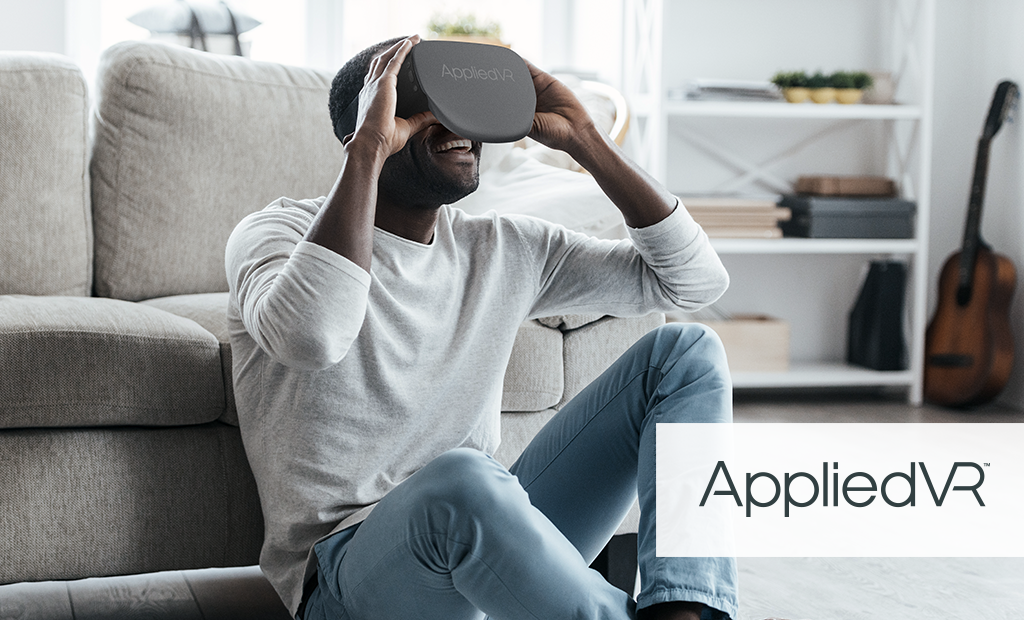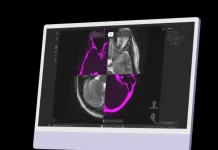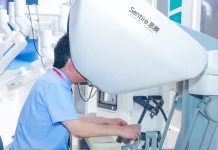In 2020, Appliedvr Inc. reported results from a three-week proof-of-concept study showing reduction of lower back pain with the use of its Easevrx virtual reality (VR) therapy. Now the company has pivotal data affirming the benefit to patients with chronic low back pain who used Easevrx at home for eight weeks.
The U.S. FDA granted a breakthrough device designation to Appliedvr for its VR-based pain therapy in October. The self-administered Easevrx program engages patients in a series of once-daily modules that present concepts and techniques based in proven practices such as cognitive behavioral therapy, mindfulness and biofeedback. The goal is to boost patients’ resilience to pain and equip them with evidence-based skills that can be applied outside of the headset to gain long-term relief.
“What is unique about this particular program is that VR offers the 3D immersive experience that engages multiple senses for enhanced learning – essentially enhanced encoding of these skills and the amount of control that a person has over their physiology, over their entire experience of pain,” said Beth Darnall, an associate professor and pain researcher at the University of California – San Francisco (UCSF) and chief science advisor at Appliedvr. “Sure, people feel better in the moment, but when these skills are applied regularly, they have the capacity to alter the structure and the functioning of the central nervous system.”

Pivotal trial
The double-blinded, sham, randomized, controlled national study analyzed data from 179 subjects who reported experiencing chronic low back pain for at least six months. Patients were randomized to receive either Easevrx, with its modules of evidence-based self-regulatory skills, or a nonimmersive placebo program featuring 2D nature scenes. Both groups got identical headsets to control for expectations.
At the end of eight weeks, the Easevrx group reported substantial improvements in pain intensity as well as pain interference across multiple domains. According to the study, published in the February 2021 issue of Journal of Medical Internet Research, Easevrx patients reported a 42% reduction in pain intensity, 49% reduction in activity interference, 52% less sleep interference and less interference in moods (56%) and stress (57%).
Overall, Easevrx users saw an 87% decline in pain, with 65% seeing their pain reduced by 30% and 46% experiencing a 50% drop.
The trial also found high levels of patient engagement, with 91% of patients completing the eight-week program. Easevrx’s usability was in the 96-100th percentile based on the System Usability Scale rating.
Los Angeles-based Appliedvr is aiming for a de novo class II submission to the U.S. FDA in the first half of this year. “We’re on a very good trajectory right now, and we hope that we’ll be able to get approved by the end of the year,” Matthew Stoudt, Appliedvr’s CEO and co-founder, told BioWorld.
Ease of use key
The intent is for Easevrx to be an “out-of-the-box, ready-to-go” pain treatment, drop shipped to a patient’s home based on a doctor’s prescription. The goal is ease of use, which is why the usability rating is so important said Stoudt. “Any time you’re sending a device, a new technology especially, into the home, ease of use is the number 1 thing that you’ve got to get right in order for this to be successful. Because I don’t care how efficacious it is; if it’s complicated clunky, it’s hard for the patient to understand, the patient’s never going to use it.”
While the current focus is on chronic low back pain, Appliedvr sees broader opportunities for its VR-based solution. Once Easevrx gets FDA clearance, the company will look at other types of chronic pain to expand the label and then start thinking about neuropathic and cancer-related types of pain. The COVID-19 pandemic has also pointed up the need for new tools to deal with isolation – a psychosocial problem that may benefit from evidence-based VR therapy, Stoudt said.
Appliedvr has previously partnered with UCSF to explore how digital therapeutic platforms, including virtual and augmented reality, can be used to increase access to care in underserved populations. The company expects to publish the results of that study in the next few months.
“Because it’s self-administered in the home, we think we have a real opportunity to be able to deliver on that notion of health equity,” Stoudt said.
The company also has received $2.9 million in grants from the National Institute on Drug Abuse and is advancing clinical studies at Geisinger and Cleveland Clinic to assess VR as an opioid-sparing tool in chronic pain and acute post-operative recovery, respectively.
As it builds clinical and real-world evidence for Easevrx, Appliedvr is also focused on the health economics advantages of its technology. In January, CMS finalized a rule that entitles breakthrough devices to national coverage upon FDA approval for a four-year evaluation period. With payers looking for innovative ways to increase access and rein in costs, Stoudt said the company has seen “tremendous interest and traction” from companies “working with us to build up that third leg of that data stool.”
Competitive space
Appliedvr is in competition with several other med-tech companies in the pain treatment space. Kaia Health Software Inc. has a CE-marked software program for self-management of lower-back pain, and Deepsen SAS has a virtual reality analgesia tool that is not yet CE marked.
Meanwhile, Lucine Technologies SAS raised $6.6 million in December to fuel development of its first digital therapy targeting relief of chronic pain. Using a smartphone or tablet camera, patients measure the extent of their pain via the Lucine mobile app as soon as symptoms appear. The mobile solution then selects suitable virtual reality and cognitive behavioral therapy sessions to stimulate the brain or distract patients from their pain.




